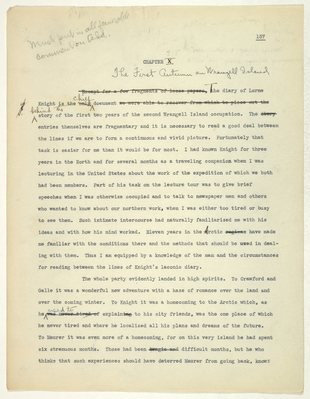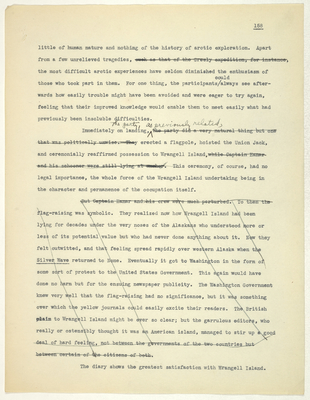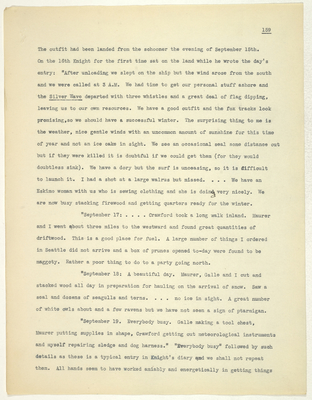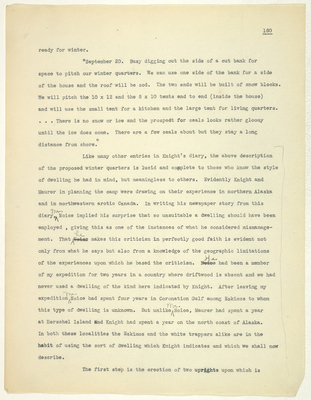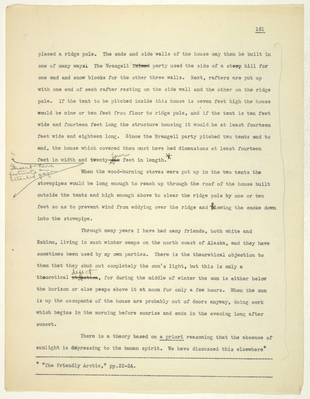Pages
stefansson-wrangel-09-29-001
Must put in all ? comment on Ada. 157
Chapter X
The First Autumn on Wrangell Island
Except for a few fragments of loose papers, The diary of Lorne Knight is the only chief document we were able to recover from which to piece out the behind the story of the first two years of the second Wrangell Island occupation. The diary entries themsevles are framentary and it is necessary to read a good deal between the lines if we are to form a continuous and vivid picture. Fortunartely that task is easier for me than it would be for most. I had known Knight for three years in the North and for several months as a traveling companion when I was lecturing in the United States about the work of the expedition of which we both had been members. part of his task on the lecture tour was to give brief speeches when I was otherwise occupied and to talk to newspaper men and others who wanted to know about our northern work, when I was either too tired or busy to see them. Such intimate intercourse had naturally familiarized me with his ideas and with how his mind worked. Eleven year in the Arctic regions have made me familiar with the conditions there and the methods that should be used in dealing with them. Thus I am equipped by a knowledge of the man and the circumstances for reading between the lines of Knight's laconic diary.
The whole party evidently landed high spirits. To Crawford and Galle it was a wonderful new adventure with a haze of romance over the land and over the coming winter. To knight it was a homecoming to the Arctic which, as he use towas never tired of explaining to his city friends, was the one place of which he never tired and where he localized all his plans and dreams of the future. To Maurer it was even more of a homecoming, for on this very island he had spent six strenuous months. Those had been tragic and difficult months, but he who thinks that such experiences should have deterred Maurer from going back, knows
stefansson-wrangel-09-29-002
158
little of human nature and nothing of the history of arctic exploration. Apart from a few unrelieved tragedies, such as that of the Greely expedition, for instance, the most difficult arctic experiences have seldom diminished the enthusiasm of those who took part in them. For one thing, the participants could always see afterwards how easily trouble might have been avoided and were eager to try again, feeling taht their improved knowledge would enable them to meet easily what had previously been insoluable difficulties.
Immediately on landing, the party, as previously related, the party did a very natural thing but one that was politically unwise. They erected a flagpole, hoisted the Union jack, and ceremonially reaffirmed possession of Wrangell Island. while Captain Hamar and his schooner were still lying at anchor. This ceremony, of course, had no legal importantce, the whole force of the Wrangell Island undertaking being in the character and permanence of the occupation itself.
But Captain Hamar and his crew were much perturbed. To them the flag-raising was symbolic. They realized now how Wrangell Island had been lying for decades under the very noses of the Alaskans who understood mroe or less of its potential value but who had never done anything about it. Now they felt outwitted, and that feeling spread rapidly over western Alaska when the Silver Wave returned to Nome. Eventually it got to Washington in the form of some sort of protest to the United States Government. This again would have done no harm but for the ensuing newspaper publicity. The Washington Government knew very well that the flag-raising had no significance, but ti was something over which the yellow journals could easily excite their readers. The British claim to Wrangell Island mgiht be ever so clear; but the garrulous editors, who really or ostensibly thought it was an American island, managed to stir up a good deal of hard feeling, not between the governements of the two countries but between certain of the citizens of both.
The diary shows the greatest satisfaction with Wrangell Island.
stefansson-wrangel-09-29-003
159
The outfit had been landed from the schooner the evening of September 15th. On the 16th Knight for the first time sat on the land while he wrote the day's entry: "After unloading we slept on the ship but the wind arose from the south and we were called at 3 A.M. We had time to get our personal stuff ashore and the Silver Wave departed with three whistles and a great deal of flag dipping, leaving us to our own resources. We have a good outfit and the fox tracks look promising, so we should have a successful winter. The surprising thing to me is the weather, nice gentle winds with an uncommon amount of sunshine for this time of year and not an ice cake in sight. We see an occasional seal some distance out but if they were killed it is doutbful if we could get them (for they would doubtless sink). We have a dory but the surf is unceasing, so it is difficult to launch it. I had a shot at a large walrus but missed. ... We have an Eskimo woman with us who is sewing clothing and she is doing very nicely. We are no busy stacking firewood and getting quarters ready for winter.
"September 17: .... Crawford took a long walk inland. Maurer and I went about three miles to the westward and found great quantities of driftwood. This is a good place for fuel. A large number of things I ordered in Seattle did not arrive and a box of prunces opened to-day were found to be maggoty. Rather a poor thing to do to a party going north.
"September 18: A beautiful day. Maurer, Galle and I cut and stacked wood all day in preparation for hauling on the arrival of snow. Saw a seal and dozens of seagulls and terns. ... no ice in sight. A great number of white owls about and few ravens but we have not seen a sign of ptarmigan.
"September 19. Everybody busy. Galle making a tool chest, Maurer putting supplies in shape, Crawford getting out meteorological instruments and myself repairing sledge and dog harness." "Everybody busy" followed by such details as these is a typical entry in Knight's diary and we shall not repeat them. All hands seem to have worked amiably and energetically in getting things
stefansson-wrangel-09-29-004
160
ready for winter.
"September 20. Busy digging out the side of a cut bank for space to pitch our winter quarters. We can use one side of the bank for a side of the house and the roof will be sod. The two ends will be built of snow blocks. We will pitch the 10 x 12 and the 8 x 10 tents end to end (inside the house) and will use the small tent for a kitchen and the large tent for living quarters. ... There is no snow or ice and the prospect for seals looks rather gloomy until the ice does come. There are few seals about but they stay a long distance from shore."
Like many other entries in Knight's diary, the above description of the proposed winter quarters is lucid and complete to those who know the style of dwelling he had in mind, but meaningless to others. Evidently Knight and Mauer in planning the camp were drawing on their experience in norhtern Alaska and in northwestern arctic Canada. In writing his newspaper story from this diary, Mr. Noice implied his surprise that so unsuitable a dwelling should have been employed, giving this as one of the instances of what he considered mismanagement. That he Noise makes this criticism in perfectly good faith is evident not only from what he says but also from a knowledge of the geographic limitations of the experiences upon which he based the criticism. He Noice has been a member of my expedition for two years in a country where driftwood is absent and we had never used a dwelling of the kind here indicated by Knight. After leaving my expedition Mr. Noice had spent four years in Coronation Gulf among Eskimos to whom this type of dwelling is unknown. But unlike Mr. Noice, Maurer had spent a year at Herschel Island and Knight had spent a year on the north coast of Alaska. habit of using the sort of dwelling which Knight indicates and which we shall now describe
The first step is the erection of two uprights upon which is
stefansson-wrangel-09-29-005
161
placed a ridge pole. The ends and side walls of the house may then be built in one of many ways. The Wrangell Island party used the side of a steep hill for one end and snow clocks for the other three walls. Next, rafters are put up with one end of each rafter resting on the side wall and the other on the ridge pole. If the tent to be pitched inside this house is seven feet high the house would be nine or ten feet from floor to ridge pole, and if the tent is ten feet wide and fourteen feet long the structure housing it would be at least fourteen feet wide and eighteen long. Since the Wrangell party pitched two tents end to end, the house which covered them must have had dimensions of at least fourteen feet in width and twenty four sixfeet in length.* Insert here footnotes on attached page
When the wood-burning stoves were put up in the two tents the stovepipes would be long enough to reach up through the roof of the house built outside the tents and high enough above to clear the ridge pole by one or two feet so as to prevent wind from eddying over the ridge and blowing the smoke down into the stovepipe.
Through many years I have had many friends, both white and Eskimo, living in such winter camps on the north coast of Alaska, and they have sometimes been used by my own parties. There is the theoretical objection to them that they shut out completely the sun's light, but this is only a theoretical defect objection, for during the middle of winter the sun is either below the horizon or else peeps above it at noon for only a few hours. When the sun is up the occupants of the house are probably out of doors anyway, doing work which begins in the morning before sunrise and ends in the evening long after sunset.
There is a theory based on a priori reasoning that the absence of sunlight is depressing to the human spirit. We have dicussed this elsewhere* -------------------------------------------------------------------------------------------------------------------- * "the Friendly Arctic," pp.22-24. --------------------------------------------------------------------------------------------------------------------
